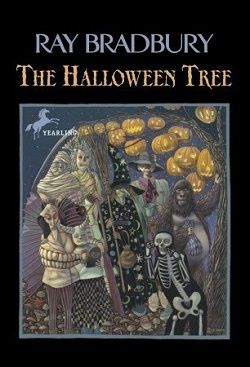Summary

The Halloween Tree
by Ray Bradbury
A fast-moving, eerie tale set on Halloween night...
Eight costumed boys running to meet their friend Pipkin at the haunted house outside town encounter instead the huge and cadaverous Mr. Moundshroud. As Pipkin scrambles to join them, he is swept away by a dark Something, and Moundshroud leads the boys on the tail of a kite through time and space to search the past for their friend and the meaning of Halloween.
.
Read
The Halloween Tree on http://kissnovel.net
Martial Peak Reviews
Ray Bradbury's The Halloween Tree is a masterful blend of fantasy, horror, and nostalgia that captures the essence of Halloween while exploring deeper themes of friendship, mortality, and the cyclical nature of life. Originally published in 1972, this novella has become a beloved classic, resonating with readers of all ages. Bradbury's lyrical prose and vivid imagery create an immersive experience that transports readers into a world where the boundaries of time and space blur, making it a perfect read for the Halloween season.
The story begins with a group of eight boys, clad in their Halloween costumes, racing to meet their friend Pipkin at a haunted house. However, their excitement quickly turns to dread when they encounter the ominous Mr. Moundshroud, a skeletal figure who embodies the spirit of Halloween. The boys' quest to find Pipkin, who has been mysteriously taken by a dark force, serves as the catalyst for their journey through time and space. As they follow Moundshroud, they are whisked away on a fantastical adventure that explores the origins of Halloween and the various cultural traditions associated with it.
One of the most compelling aspects of The Halloween Tree is its exploration of the theme of mortality. Bradbury does not shy away from the darker aspects of life; instead, he embraces them, encouraging readers to confront their fears and understand the significance of death in the human experience. Through their journey, the boys encounter various historical figures and cultural practices that highlight how different societies have grappled with the concept of death. This theme is poignantly illustrated when the boys witness the ancient rituals of the Celts, the Day of the Dead celebrations in Mexico, and the somber reflections of the Egyptians. Each encounter serves to deepen their understanding of Halloween as not just a night of fright, but as a celebration of life and death intertwined.
Character development is another strong suit of Bradbury's narrative. The boys, initially portrayed as carefree and somewhat superficial in their excitement for Halloween, undergo significant growth throughout their journey. Each character represents different facets of childhood innocence and fear, and as they confront the reality of loss and the unknown, they emerge more mature and introspective. Pipkin, the missing friend, serves as a poignant reminder of the fragility of life and the bonds of friendship. His absence propels the boys into a deeper understanding of their own fears and the importance of cherishing their relationships.
Bradbury's use of language is nothing short of poetic. His descriptions of the Halloween night, the eerie landscapes they traverse, and the historical settings they visit are rich with sensory detail. The atmosphere he creates is both enchanting and unsettling, perfectly capturing the duality of Halloween as a time for both celebration and reflection. Phrases like "the wind whispered secrets" and "the moon hung like a ghostly lantern" evoke a sense of wonder and eeriness that lingers long after the last page is turned. This vivid imagery not only enhances the reading experience but also serves to immerse readers in the thematic depth of the story.
Another notable aspect of The Halloween Tree is its ability to resonate with readers on multiple levels. While it is a children's story at heart, the themes of friendship, loss, and the celebration of life and death make it equally poignant for adult readers. Bradbury's exploration of cultural traditions surrounding Halloween invites readers to reflect on their own experiences and beliefs, fostering a sense of connection across generations. This universality is what makes the novella a timeless classic, appealing to both young readers discovering the magic of Halloween for the first time and adults revisiting their childhood memories.
In comparison to other works that explore similar themes, such as Neil Gaiman's The Graveyard Book or Tim Burton's The Nightmare Before Christmas, Bradbury's novella stands out for its rich historical context and philosophical depth. While Gaiman and Burton also delve into the interplay between life and death, Bradbury's narrative is steeped in a sense of reverence for the past and the traditions that shape our understanding of mortality. His ability to weave together history, folklore, and personal growth creates a tapestry that is both educational and emotionally resonant.
Ultimately, The Halloween Tree is more than just a tale of adventure; it is a profound meditation on the nature of existence and the importance of embracing both the light and dark aspects of life. Bradbury's ability to blend the whimsical with the macabre invites readers to celebrate Halloween not only as a night of costumes and candy but as a time to reflect on the deeper meanings of life and death. The novella serves as a reminder that while fear is an inherent part of the human experience, it is also a catalyst for growth, understanding, and connection.
In conclusion, Ray Bradbury's The Halloween Tree is a beautifully crafted story that captures the spirit of Halloween while delving into profound themes that resonate with readers of all ages. Its rich imagery, character development, and exploration of mortality make it a must-read for anyone seeking to understand the deeper significance of this hauntingly magical holiday. Whether you are revisiting this classic or discovering it for the first time, prepare to be enchanted by Bradbury's timeless tale.













![Crimson Karma [Official]](/upload/pic/manga/crimson-karma--official-.jpg)










Reviews 0
Post a Reviews: